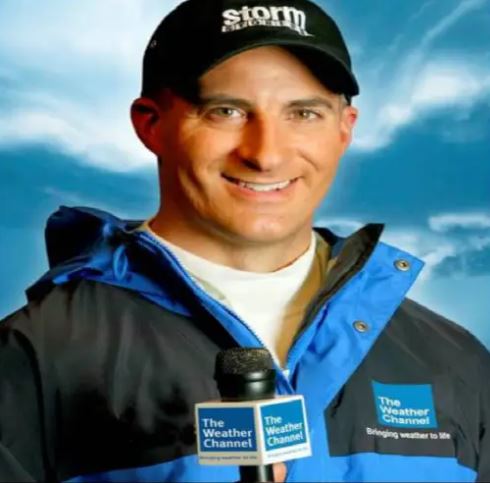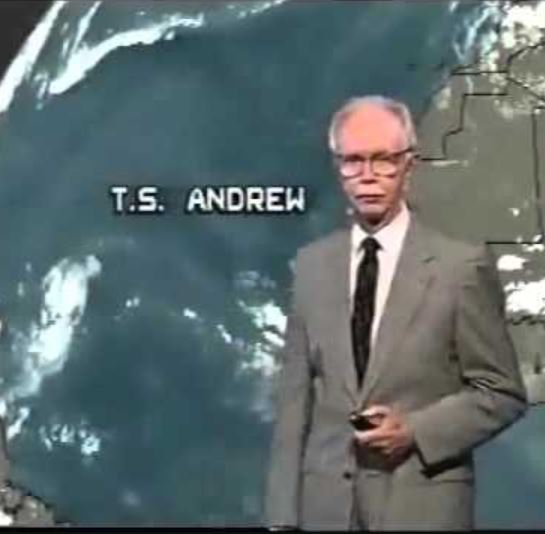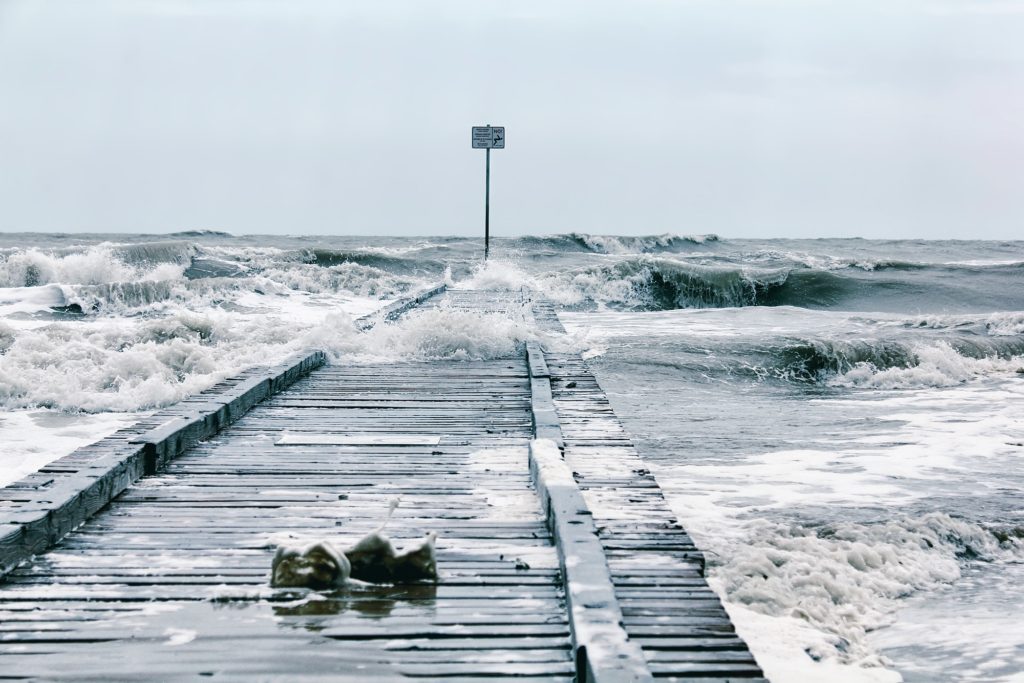Since the early twentieth century, the way that weather information has been communicated to the public gradually changed. From the 1950s to the 1970s, American lifestyles were ever-changing and so was the demand for weather information. There was also a need for more timely weather warnings that could be rapidly communicated to the public. On May 2, 1982, The Weather Channel launched its network on cable TV, and weather communication to the general public was revolutionized.
Timeline
According to sangamoncountyhistory.org, the first weather report was a test transmitted by “wireless telegraphy” from Illiopolis, Illinois, in April 1915. The transmission was received across most of the state and was supplied by Clarence Root, a meteorologist and the Director of the U.S. Weather Bureau in Springfield, Illinois.
A forward thinker, Mr. Root had this to say about the future of weather communication: “I believe that wireless will, in the future, be the method of distributing weather forecasts. The plan has never been used before. It is much quicker than the mail. In times of frosts or approaching storms, the information is of inestimable value to farmers and growers.”
The first commercial radio station in the U.S. was KDKA in Pittsburgh, Pennsylvania, which launched on November 2, 1920. KDKA broadcast news and weather information that could be heard by the public on the radio.
The first commercial radio station in the U.S. (KDKA) in Pittsburgh, Pennsylvania) was the first to broadcast news and weather information over the airways in 1920. Photo Credit- Wikipedia-Pubic Domain.
A New York Times article indicated that the first televised weather report occurred on October 14, 1941, from WNBT in New York. The report was given by a cartoon character “Wooly Lamb”. Since hardly anyone owned a television set then, only a few could see the report.
In the 1950s, the newscast weather segment became more of an afterthought. It was perceived that more entertainment was needed and the TV “weatherman” became more of a character than a scientist. Cartoon characters, crazy stunts, and wild costumes became more of the norm.
Some “entertainers” became household favorites. Willard Scott, who achieved fame on the Today Show, was originally on WRC TV in Washington, D.C. Besides presenting the weather, he played Bozo the Clown and he was the original Ronald McDonald.
Some stations hired young females who were dubbed “weathergirls”. The concept quickly caught on and many TV markets nationwide had “weathergirls”. These women were not meteorologists, that trend would be decades away. Since most women seen today on TV weather broadcasts are degreed meteorologists, “weathergirl” should be a term of the FAR distant past!
Societal changes resulted in more people moving around the country and taking advantage of more leisure time. The demand for weather information increased rapidly, along with the need for specific information. Receiving weather information on the 6 and 11 o’clock news wasn’t enough. Critical weather warnings for tornadoes, hurricanes, and snowstorms were not being received and communicated on time. Weather warnings read by radio DJs (often too late) were not acceptable anymore.
Technological advances with the development of computer weather models allowed for better forecasts and those forecasts could be extended to three days. Weather satellites were relaying valuable information from around the globe at a faster pace, too.
NOAA weather radio was able to broadcast weather warnings and other information beginning in the 1950s but most households didn’t own a weather radio.
During the 1970s, the public’s demand for more weather information increased dramatically. in the late 1970s John Coleman, who was a meteorologist for Good Morning America, hatched a plan for a 24-hour cable network. After a long, and sometimes frustrating journey, the plan came to fruition. On May 2, 1982, The Weather Channel was launched and it became a key moment in the history of weather communication to the public. I was extremely fortunate to be a tiny part of it.
A Dream Becomes A Reality
John Coleman was a persistent man, he had to be to make a dream of his come true. As a Meteorologist for Good Morning America, John realized that a brief weather report in the morning or other brief reports during 6 p.m. and 11 p.m. newscasts came up short of what the public expected and needed.
The National Weather Service was able to generate more information (e.g. tornado watches and warnings) but there was no efficient or timely way to communicate it to the public.
Television was in the midst of a great change as broadcasts could be seen across the nation via satellite. All news networks like CNN were launched. John envisioned a national cable TV weather network in 1977. He tried to pitch his idea, to receive some support, from the major TV networks first.
He often accomplished this by traveling long distances, in addition to his responsibilities at Good Morning America. The original name for his proposed network was Satellite Weather Service.
John Coleman’s concept for a national cable TV weather network was included in a brochure that was distributed at a national cable convention. Image Credit – Weather Channel Pioneers Book.
To make a long story short, there was rejection after rejection of his idea. In some of his rejection letters, there was a reference to “your weather channel”. Finally, Landmark Communications agreed to partner with John to launch and the name The Weather Channel was adopted. At that time, Landmark-owned newspapers and other small publications, plus two local TV stations.
In addition to broadcasting national weather, and other features, 24 hours a day, it was impossible to persuade local cable TV affiliates to add The Weather Channel to their roster of cable stations without some “localization”.
The Weather Channel development group, led by Alan Galumbeck, created the “Weather Star” Satellite Transponder Addressable Receiver that could capture and format NWS forecasts and automatically transmit them from a satellite to a receiver (Weather Star) that would be located at a particular cable TV location. Because of this, viewers could receive their own local forecast. Weather instruments could also be sent to cable affiliates to indicate current conditions.
John’s weather support meteorologist was Joe D’Aleo who had been the former head of the Meteorology Department at Lyndon State College. Joe became the first Director of Meteorology at The Weather Channel. John Coleman was the network’s first President.
A 1982 photo of John Coleman (the first TWC President) on the left and Joe D’Aleo (the first TWC Director of Meteorology). Photo Credit- The Weather Channel Pioneers Book.
My Career Path Changed In An Instant
In the summer of 1981, I worked for the government in Washington, D.C. My work involved some environmental testing but I wanted to switch to weather forecasting, which I always wanted to do since I was very young. I had also broadcast the weather at a local cable TV station in Upstate New York when I was a meteorology major in college.
I decided to subscribe to the American Meteorological Society Jobs Bulletin. I would receive the publication every month and it would contain various job openings around the nation. In October I saw that a 24/7 cable weather network was launching and they needed meteorologists.
To make this story short, I sent a resume and a letter practically begging to be hired.
In early January I received a call and a job offer in the Meteorology Department. It would be a few years before I became a full-time On-Camera Meteorologist. With the other original hires, I moved to Atlanta and walked in the door to start work on March 1, 1982. For the next two months, we became acclimated to our jobs, and kinks were worked out, while the on-air talent prepared for broadcasts by doing mock shows.
Finally, on May 2, 1982, the Weather Channel was launched during a national cable show in Las Vegas, Nevada. Many employees, myself included, were at The Weather Channel for the ceremony. There would be one-hour shows with two on-camera meteorologists around the clock with various weather segments (e.g. national radar). The original broadcast that evening featured Bruce Edwards and Andre Bernier (seen in the featured image).
Pundits and naysayers said that we wouldn’t last a year, but we proved them wrong (barely) !
Information Revolution
At long last, the public could get weather information ANY time of day. They could receive their local forecast several times an hour. One of the great features of the Weather Star was that all NWS weather warnings would crawl on your TV screens. For example in a tornado warning, your screen would turn red and the warning text would scroll. I’m sure that we saved countless lives with this “cutting-edge” technology.
The Weather Channel also made it a point to educate the public with various initiatives. In TWC’s early days, it was one-minute vignettes such as the “Meteorological Minute” and “Neat Stuff”. Later, more sophisticated 1-hour presentations, featuring famous weather events, became commonplace.
In the early 1990s, TWC launched “The Weather Classroom”, a series of 30-minute shows covering weather topics. The shows appeared overnight and teachers were encouraged to tape them on VCRs. A textbook, that could be ordered, accompanied the shows. I was so happy to have been a part of the development of “The Weather Classroom”.
Live On-Site Reports
Over the past few years, hundreds of local and national media outlets have covered a major weather event remotely from the field. The Weather Channel got the ball rolling with this.
In TWC’s early days, many of us suggested that we cover live weather events but it just wasn’t in the budget to do so. The Weather Channel came within an eyelash of closing down after a tumultuous second year when John Coleman was ousted and the network was bleeding money. It was an odd twist of fate that kept us alive, but once again I might tell that story at another time.
Eventually, The Weather Channel landed on more stable ground and it began to cover weather events in the field. I remember the tremendous job that Dennis Smith and Cindy Prezler did with their live reports during Hurricane Hugo around Charleston, South Carolina in 1989.
The Weather Channel expanded live coverage to other events like snowstorms and severe weather. Meteorologists like Jim Cantore and Mike Seidel became household names. Over time, other national networks and local TV stations followed suit and live reports accompanied every major event.
Jim Cantore became a familiar face to millions with his on-site reports of major weather events on The Weather Channel. Image Credit-Wikimedia Commins-Public Domain.
Weather “Experts”
These days, “experts” on TV are commonplace with local and national TV entities following the lead of The Weather Channel. Now, experts are not hired by the media just for weather just for weather, you see them on news and business networks frequently. Our first “weather expert” was John Hope, often known as the “Hurricane Man”.
John served in the U.S. Army Air Corps as a meteorologist during World War II. Later, he was an advisor to NASA providing critical forecasts for their manned space launches in the 1960s. John later became a senior hurricane specialist at the National Hurricane Center. Before being hired by The Weather Channel as an On-Camera Meteorologist/Hurricane Expert at our startup, he gave presentations worldwide on tropical meteorology topics.
John Hope was often called the “Walter Cronkite” of TV weather because of his great expertise in tropical meteorology and calm demeanor when communicating important information. Image Credit-You Tube
I could write volumes about how much I liked and respected this man. John added instant credibility to the network with his calm “no-nonsense” approach to conveying critical weather information.
After John Hope, Dr. Steve Lyons was TWC’s tropical expert. In more recent times, Dr. Rick Knabb took over those duties, Dr. Knabb had been the Director of the National Hurricane Center.
Dr. Greg Forbes, a disciple of the great severe weather researcher Dr. Ted Fujita, has served as the severe weather expert. TWC even had a “climate expert” Dr. Heidi Cullen. Paul Kocin and then Tom Niziol have served as winter weather experts at the network.
It doesn’t seem like 42 years ago when I was at The Weather Channel, along with my peers, for the network launch on that May evening. I am so fortunate to have been part of this piece of weather history and to have worked with and learned from a multitude of great professionals!








